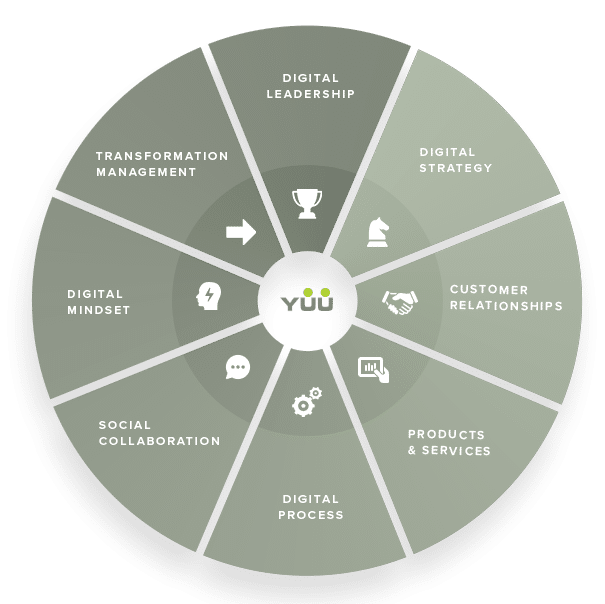How to turn your business into a butterfly: 8 dimensions for a successfull digital transformation

When it comes to change processes in companies, ’digital transformation’ is currently the most used buzz word. The term itself has two sticking points: ’digital’ and ’transformation’. As professional consultants we experience on a daily basis: If you want to explain to a decision-maker, why digital transformation is crucial for the company’s economic success, you have to fill the term with relevant and practicable processes. Starting with today’s blog series, this is exactly our intention. Let’s begin with a general overview.
The digital transformation in companies consists of eight dimensions:
- Digital Leadership
- Digital Strategy
- Digital Customer Relationships
- Digital Products
- Digital Processes
- Social Collaboration
- Digital Mindset
- Digital Transformation Management
‘Digital’ is only the cause
At first the meaning of ’digital’ needs some clarification. Most of the people still only think of technical aspects in this context: Digital is the result of what computer scientists developed of zeroes and ones in the 70s and 80s – such as computers, software, devices or applications. And supposedly this has something to do with companies, processes and employees. But this association is incorrect. ’Digital’ is rather the base for the establishment of new processes, business areas, products, value systems, models and production lines. In other words: The changes in the business world originate from the digitalization of our lives. This forces companies to change on all levels: a transformation.
What is ‘transformation’?
A transformation is something different than a conventional change process, namely a timed initiative of a clearly defined process. In contrast, a transformation is a portfolio of different initiatives which are intertwined and linked to each other. It calls for the development of a new business model based on a vision for the future. In other words: ’When a snake sheds its skin it changes; when a caterpillar becomes a butterfly, it transforms.’ Even the best change management for several different initiatives cannot ensure a successful transformation process overall. To put it in positive words: A transformation will only work if it follows a holistic approach and sets in on all levels. An example? The most beautiful CRM tool is of no use if the customer service employees have not yet internalized digital customer orientation in their minds. They have to be guided by their leaders. Thus, four dimensions already set in: Digital Leadership, Digital Customer Relationships, Digital Mindset and Digital Transformation Management.
1. Digital Leadership
This is the digital transformation’s core discipline. Without a new leadership culture digital transformation is unthinkable. The leaders of today (and tomorrow, of course) have to incorporate the success models of the digitalization into their daily management style. This requires maximum transparency, decision making in uncertain times as a result of the networking of digitally managed developments, the openness for new products, approaches, tools and value systems, the participation of the employees in relevant decisions as well as the agility regarding planning processes. We call this principle NOPA, a new leading concept for the digital age. This principle does not mean that conventional, hierarchic, long-term and regulated processes become obsolete. But it requires every decision-maker to choose between ’old’ and ’new’ leadership. The backlog of many companies manifests itself: The ’old’ management is in a comfortable position whereas the ’new’ management is not.
2. Digital Strategy
Agility or dynamic management are often mistaken for arbitrariness. Some modern leaders – or the ones who consider themselves to be – enjoy the supposed deregulation and think that elaborate planning, analysis and evaluation finally belong on the shelf. But this is a misunderstanding. A butterfly is also not going to come to existence just because an inspired caterpillar randomly picks up ideas and moves without focus. Digital transformation requires a strategy. This means that at least a proactive approach has to be taken in order to establish a vision, that the status quo in specific company core areas is analyzed, that necessary steps or products and processes are restated and that they get implemented. Within this strategy adaptations and experiments can and probably have to take place. Without a strategy it is merely going to be a self-defeating play in digital subareas with no significant benefit to the company’s success. Let’s keep in mind: A new business strategy needs proper accompanying communication!
3. Digital Customer Relationships
Most of us are digital customers ourselves. Therefore we should know about the expectations of today’s customers towards offering companies: fast feedback, high flexibility, individualized contact and direct communication through all the channels that are possibly available. Although being aware of these requirements, companies still fail. In this case companies unavailingly try to impose a new customer relationship management on outdated structures and leadership concepts. New customer requirements demand not only new tools, but also a change in the minds of the responsible employees. They need a transition to a different mindset and have to be guided in a particular way that enables fast, direct and individual contact with the customer. A customer service department where processes have to pass through three to eight hierarchy levels before creating change will not please digital customers. ’Excuse me, in this case my hands are tied’ – nobody has ever wanted to come to term with this fact. In the digital business world this excuse consequently means: ’Goodbye forever!’
4. Digital Products
Apple Watch, driverless cars, smart homes. These innovations form the spearhead for digital products in the future, but the digital transformation is not all about these innovations. In fact, there is no business area any more that does not offer digitalized products or services. From a garden plant to a tea or a credit – nothing is excluded by digitalization. If you do not offer digitalized products or services, you will loose your customers at one point or another. Moreover: Digitalized products or services need to be updated on a regular basis, they have to provide touch points with existing systems. Forget silo mentality!
5. Digital Processes
Digital transformation does not only include technical products, resulting from the keyboards of ingenious developers, it also includes the processes that go along with the mechanics of these developments. In other words: All the working processes in the digital area call for a procedure which is agile, inter-divisional or even company-wide, networked, automated and standardized – at least touching points to such working processes are required.
6. Social Collaboration
Along with theses processes a new form of social collaboration emerges. This term sums up different formats and tools. They all have in common that the internal and external corporate communication can be designed highly networked and take place across divisions and hierarchies – regardless of time and place. This form of communication increasingly replaces former collaborative structures. This includes a social intranet which encourages the communication among the employees, or digitalized solutions for networked collaboration like Jive, Confluence, Yammer, Chatter and Skype, or sharing best practices through Slideshare or white papers and new participative co-creation formats like BarCamps or Open Spaces. There is no doubt: Employees who have been raised in the digital world are used to this form of networked collaboration.
7. Digital Mindset
This is a dimension that modern companies have to internalize. Think about the definition of ’digital’ at the beginning. It is (not only) about digital technologies, but also about understanding the economical processes that have changed due to digital technologies. And this is linked to pragmatical components. On the one hand companies have to make sure that employees are confident with relevant applications; after all ensuring the employees’ digital competence is an assignment for the management. On the other hand digitalized processes have to be used to further innovation and business processes. That is: After the final report projects have to be reviewed in a retrospective, learnings are to be consequently integrated in future projects and failures will be communicated proactively rather than be concealed. Think about it: How much time do you spend on critical reflection and learning from past mistakes?
8. Digital Transformation Management
Digital transformation is not going to succeed by chance. It rather requires a roadmap with specified milestones giving orientation along the transformation process. Hereby it is important not only to define measurable (intermediate) goals, but also to control them on a regular basis. The same applies to the distribution of roles and responsibilities as for the establishment of decision making processes. Two specialized units are usually mentioned in publications: IT and Marketing. Their relationship is often characterized by conflicts. That is a pity because they actually would make an excellent combination to take on the lead. But also every other related business department is supposed to be aligned in the process of digital transformation, therefore, resources are needed. In other words: Leaders have to give digital transformation a high priority. Thus, we have come full circle: The core of digital transformation is the leadership.
How to start?
With our Digital Transformation Diagnosis we identify the field of activities and potentials of digital transformation in your company.
Based on this analysis we develop a strategy with you, whether if you are still at the beginning or already advanced in matters of digitalization. From medium-sized to large companies, we will support you! Feel free to contact Anja Hahn.










